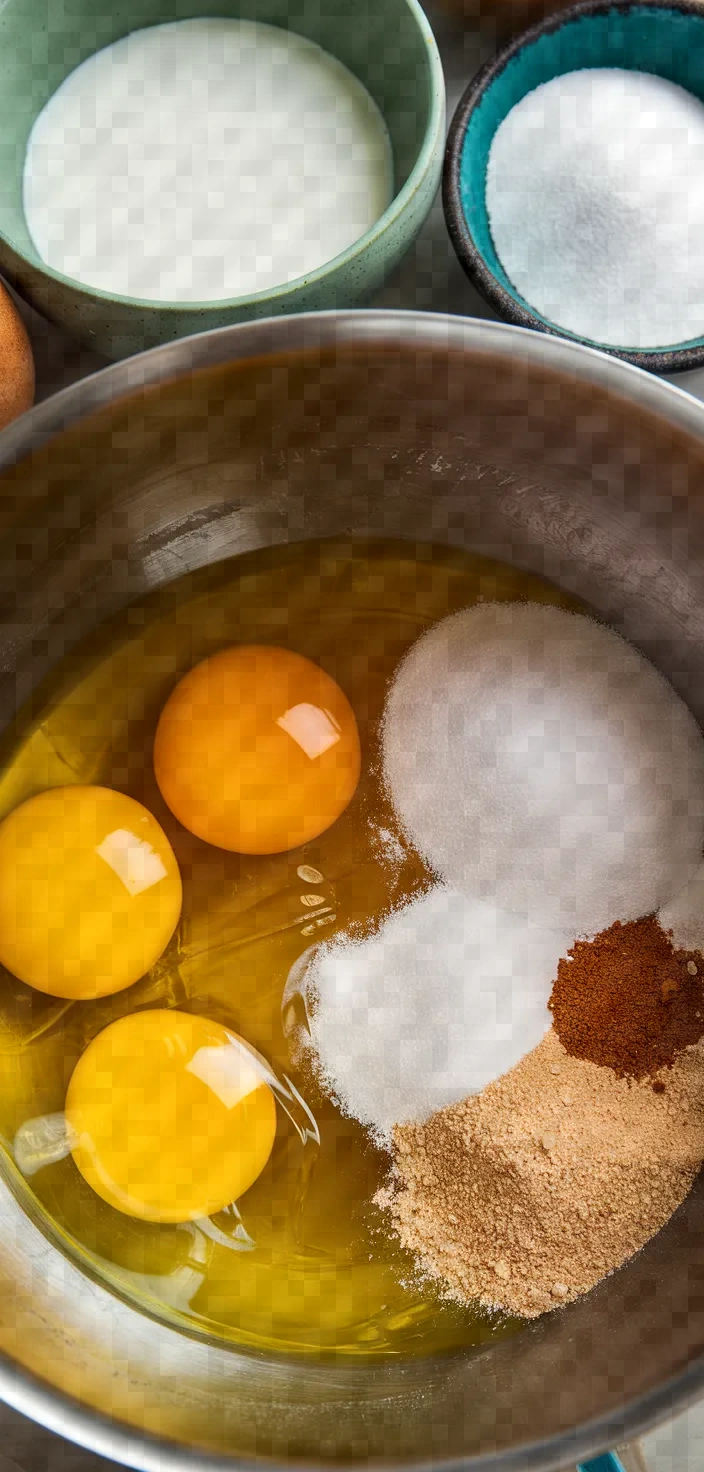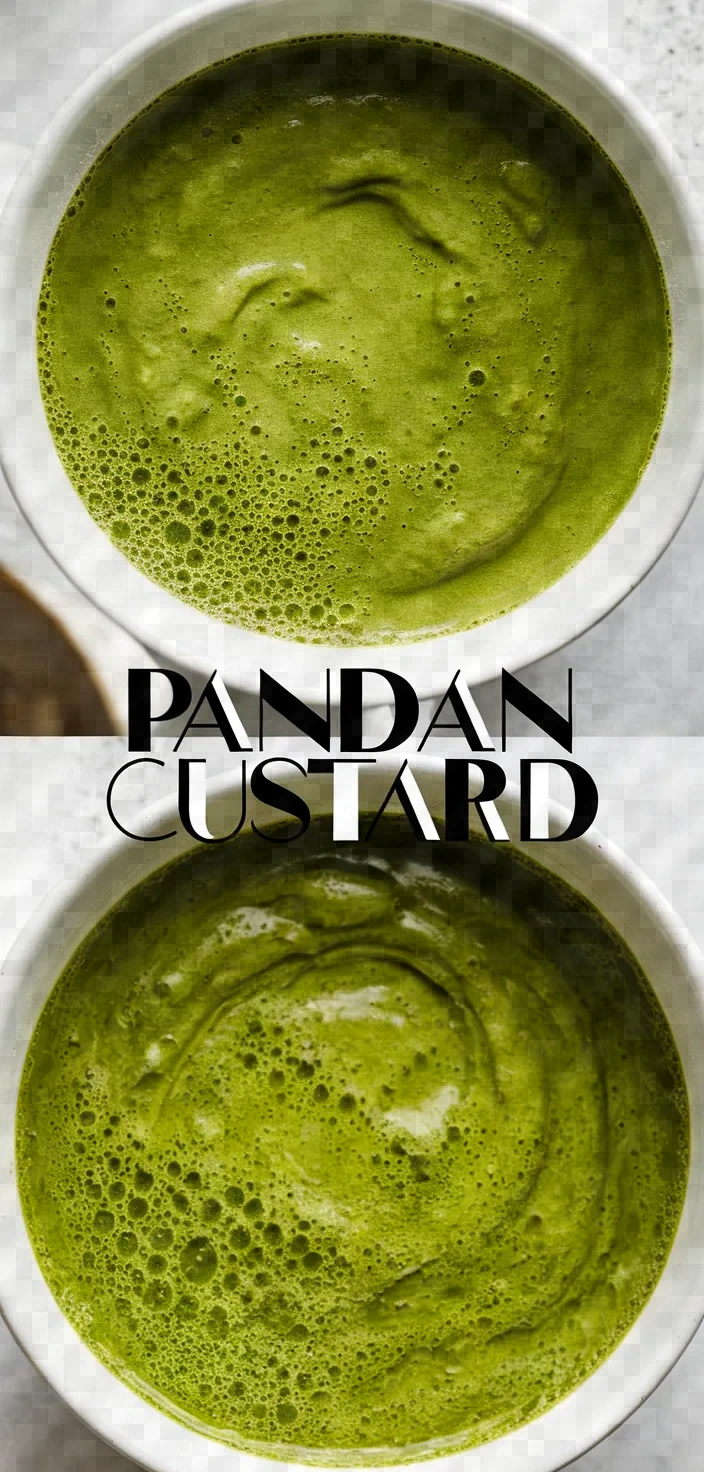I absolutely love this recipe because it delivers that dreamy, aromatic flavor fusion of pandan and coconut, transporting me right to the tropics with every spoonful. Plus, it’s incredibly versatile, whether I enjoy it warm or chilled, and it pairs perfectly with so many other sweet treats!

The fragrant combination of coconut milk and pandan juice in this custard is something I adore. My formula defines it with 4 large eggs, 3/4 cup granulated sugar, and a little salt for balance.
If you want it thicker, add cornstarch. And it’s not just good; it’s unbelievably good, with a wonderful coconut undertone that complements the flavors targeted by using fresh pandan leaves (or their juice).
Ingredients

Protein-packed, providing a creamy texture and structure, eggs are.
Milk of Coconut: Offers depth and a flavor redolent of the tropics, in an emulsion of finely divided unctuousness and an abundance of healthful fat.
Juice from the Pandan plant: Offers a distinct fragrance and a bright green hue.
Sugar in Granules: Sweetens the custard, balancing flavors.
Sodium chloride: Intensifies taste, countering sugar and fat.
Ingredient Quantities
- 4 large eggs
- 1 cup coconut milk
- 1 cup pandan juice (from fresh pandan leaves)
- 3/4 cup granulated sugar
- 1/4 teaspoon salt
- 1 tablespoon cornstarch (optional, for thicker consistency)
- 1/4 teaspoon vanilla extract (optional)
Instructions
1. In a blender, mix the pandan leaves with a small amount of water and blend until completely liquefied. Pass the mixture through a very fine sieve to extract the juice from the pandan leaves. You should have 1 cup of pandan juice. If you don’t, repeat with leftover leaves.
2. In a medium-sized mixing bowl, beat the eggs well.
3. Incorporate the coconut milk, pandan juice, and granulated sugar into the eggs. Whisk until the sugar dissolves completely and the amalgam is smooth.
4. Mix the salt and cornstarch (if using) in well. You want them to be distributed evenly, with no lumps, and for the cornstarch not to be acting like cornstarch and clumping together. A smooth finish is really key here.
5. Include the vanilla extract to amp up the flavor, if you wish, and mix thoroughly.
6. Put the custard mixture into a saucepan and set it over medium-low heat.
7. Continue mixing the amalgam with a wooden spoon or spatula, taking care not to let it stick to the bottom and ensuring that it heats evenly. If you have a double boiler, use it for this step; it will provide gentle, even heat and help prevent your mixture from scorching.
8. Keep cooking the custard until it thickens to the consistency you want. This usually takes about 10-15 minutes.
9. When the custard has thickened, take it off the heat and allow it to cool to room temperature. As it cools, it will thicken even more.
10. Pandan custard can be served warm or chilled, depending on your desire. It is so versatile that it can be almost enjoyed in any aspect of dessert. It is delicious on its own but can be used to complement various desserts in many different forms.
Equipment Needed
1. Blender
2. Fine sieve
3. Medium-sized mixing bowl
4. Whisk
5. Measuring cups
6. Measuring spoons
7. Saucepan
8. Wooden spoon or spatula
9. Double boiler (optional, but recommended)
FAQ
- Q: Can I use pandan extract instead of fresh pandan leaves?A: Yes, pandan extract can be used in place of the fresh leaves, but since the extract is more potent, you’ll want to use a lesser amount. Adjust to your taste and make sure not to overpower your dish.
- Q: How do I make pandan juice from fresh leaves?A: Chop up fresh pandan leaves and mix them with a tiny bit of water. Pour the resulting mixture through a fine sieve into a bowl, letting the liquid drip in while you work. What you have now is a bowlful of concentrated pandan juice, ready to use in any recipe.
- Q: Is cornstarch necessary for the recipe?A: No, cornstarch is optional. It is used to thicken the custard, but the custard will still set without it.
- Q: Can I use another type of milk instead of coconut milk?A: Yes, you can switch in regular dairy milk or other plant-based milks, but coconut milk is what really gives it that rich, authentic flavor.
- Q: How should I store the pandan custard?A: An airtight container is suitable for storing custard in the refrigerator. It can be kept there for three days or fewer.
- Q: Can the pandan custard be frozen?A: It is not recommended to freeze the custard, since it may thaw out to a watery consistency.
- Q: What if I don’t have access to fresh pandan leaves?A: If you can’t find fresh pandan leaves, try going with pandan paste or extract. You can find these in almost any Asian grocery store.
Substitutions and Variations
When a recipe calls for coconut milk, you can substitute almond milk or a mixture of heavy cream and water. Using almond milk will bring an entirely different flavor to your dish and slightly different texture. It is the most coconut-like in flavor of the substitutes. A mixture of heavy cream and water will impart a wealth of creamy flavor and texture; if anything, this substitute brings you closer to coconut milk in wealth of flavor and creamy mouthfeel.
For pandan juice: Mix water with matcha (green tea) powder for a different but equally rich flavor in this green juice.
For granulated sugar: Use coconut sugar or maple syrup for a distinct taste and added depth.
To thicken the custard, you may use any of the following: cornstarch (optional); tapioca starch; arrowroot powder.
Pro Tips
1. Pandan Juice Freshness Use fresh pandan leaves to make the pandan juice; this will give your custard a more vibrant color and a stronger, more authentic flavor. Freeze pandan leaves if you need to store them for later use, so they maintain their freshness.
2. Egg Mixing Technique Beat the eggs gently without over-whisking. Over-whisking can incorporate too much air, which might cause the custard to have an odd texture when cooked.
3. Cornstarch Sifting If you choose to use cornstarch for a thicker consistency, sift it into the mixture to avoid clumping. This ensures a smooth custard and helps distribute the cornstarch evenly.
4. Double Boiler Recommendation When cooking the custard, using a double boiler instead of direct heat can prevent curdling and ensure even cooking. This gentle heating method provides more control to achieve the perfect consistency.
5. Chilling and Skin Prevention To prevent a skin from forming on the surface of the custard as it cools, place a piece of plastic wrap directly on the surface. This will ensure a smooth texture throughout.

Pandan Custard Recipe
My favorite Pandan Custard Recipe
Equipment Needed:
1. Blender
2. Fine sieve
3. Medium-sized mixing bowl
4. Whisk
5. Measuring cups
6. Measuring spoons
7. Saucepan
8. Wooden spoon or spatula
9. Double boiler (optional, but recommended)
Ingredients:
- 4 large eggs
- 1 cup coconut milk
- 1 cup pandan juice (from fresh pandan leaves)
- 3/4 cup granulated sugar
- 1/4 teaspoon salt
- 1 tablespoon cornstarch (optional, for thicker consistency)
- 1/4 teaspoon vanilla extract (optional)
Instructions:
1. In a blender, mix the pandan leaves with a small amount of water and blend until completely liquefied. Pass the mixture through a very fine sieve to extract the juice from the pandan leaves. You should have 1 cup of pandan juice. If you don’t, repeat with leftover leaves.
2. In a medium-sized mixing bowl, beat the eggs well.
3. Incorporate the coconut milk, pandan juice, and granulated sugar into the eggs. Whisk until the sugar dissolves completely and the amalgam is smooth.
4. Mix the salt and cornstarch (if using) in well. You want them to be distributed evenly, with no lumps, and for the cornstarch not to be acting like cornstarch and clumping together. A smooth finish is really key here.
5. Include the vanilla extract to amp up the flavor, if you wish, and mix thoroughly.
6. Put the custard mixture into a saucepan and set it over medium-low heat.
7. Continue mixing the amalgam with a wooden spoon or spatula, taking care not to let it stick to the bottom and ensuring that it heats evenly. If you have a double boiler, use it for this step; it will provide gentle, even heat and help prevent your mixture from scorching.
8. Keep cooking the custard until it thickens to the consistency you want. This usually takes about 10-15 minutes.
9. When the custard has thickened, take it off the heat and allow it to cool to room temperature. As it cools, it will thicken even more.
10. Pandan custard can be served warm or chilled, depending on your desire. It is so versatile that it can be almost enjoyed in any aspect of dessert. It is delicious on its own but can be used to complement various desserts in many different forms.
